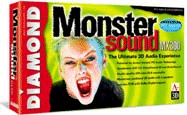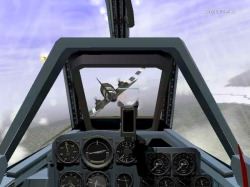| Diamond MX300 by John "Mjolnir" Reynolds |
||||
|
I'd like to begin this review on a less-than-positive note: I've never been that fond of Diamond or its weak customer support, and usually avoid their products like I do Todd Porter games.
And I feel almost dirty having a Diamond product in my custom-built gaming rig; it's as if I've somehow degraded the quality of my computer as an otherwise shining example of how to do-it-yourself. Yet the Monster MX300 beckoned to me with its A3D 2 standard (fully compatible with A3D 1), 4-speaker support, and 96-voice hardware streams. And against the odds, at least in my mind, the MX300 has proven itself to be no diamond in the rough
Let's really start at the beginning, with installation woes and worries, a place gamers either love or hate depending on their technical expertise and comfort with case-cracking. Well readers, rejoice, for I've installed the MX300 in several different systems without a single problem. And Diamond's even upgraded their former would-be manual of a CD holder to 30+ pages of actual documentation.
In fact, the only installation glitch I discovered was that the standard gameport associated with most pre-installed sound cards doesn't seem to be disabled by the installation routines in favor of the Monster Sound II gameport. In other words, you'll most likely have to manually change the Port Driver in the Game Controllers' Advanced tab from standard to the Monster gameport in order to get your favorite controller up and running.
And speaking of controllers, former Monster sound cards were notorious for their problems working with digital sticks. I'm happy to report that the MX300, tested with both a MS Sidewinder 3D Pro and gamepad, worked just fine, which is one less thing for a potential buyer to worry about.
The older generations of Monster sound cards also lacked DOS legacy support for those aging games that still hold a special place in your heart--unless you count a completely lame, internal pass-thru cable that required you leave your old ISA sound card installed! In contrast, the MX300 ships with DOS legacy Sound Blaster emulation drivers that actually work. I did manage to discover a few older games that I couldn't get to cooperate with the card, but, by and large, DOS games installed without a hitch and sounded better than ever.
Once I was done testing its Sound Blaster emulation, I was eager to hear the card's A3D support. Unfortunately for flight sim junkies, myself included, the flight genre has become the absolute last type of game to embrace 3D sound standards, with even the real-time strategy games beating sims to market with the release of Myth 2, which supports both EAX and A3D. So instead, I bypassed WW2 Fighters or Longbow 2 (but we'll come back to these two later) and tried out Heretic 2 and Thief, action games that are at the forefront, as a genre, of evangelizing 3D sound in computer games.
If any title can serve as a platform for the A3D standard like Quake 1 and 2 did for 3Dfx's Voodoo chipsets, it's Heretic 2. A visual feast, this Quake 2-based game provides an aural assault of the best kind when running on the MX300; I immediately noticed the sound quality improvements, from the crisp, clean patter of Corvus' individual footsteps to the tectonic rumblings of his Storm Bow. Put simply, the difference in sound was on par with the difference between the game's software renderer and its accelerated modes!
Excited, and eager for more, I bought a set of satellite speakers and cabled them to the second output jack, positioning them to be directly behind me while sitting in front of my computer. I then fired up Thief: The Dark Project, a game that forces the player to use both his eyes and ears to succeed, for it casts you in the role of a master thief who must use stealth over strength to achieve his goals.
Hiding in shadows, an entire second world came alive around me, based entirely on positional audio cues: patrolling guards, gossiping servants, the moans of the undead. And with the MX300 and four speakers, I could just intuitively discern the direction from which any sound was emanating.
Yet it appears that the MX300 does all of its 3D positional signalling through only the front speakers, leaving the rear output speakers to sort of fill the void behind the player. But for totally immersive gameplay, four speakers and a subwoofer are definitely worth the investment. Pop on a set of headphones and it's near to heaven!
|
But what about titles that don't support the new 3D sound standards, such as current flight sims? Installing WW2 Fighters by Janes, I loaded up an instant mission and was greeted with extremely clean output, with no noticeable static or hissing. The planes sounded great, especially with the option of Complex Engine Noise enabled, but didn't overshadow the guns, which pounded through my Altec Lansing subwoofer with desk-rattling force. I've read that WW2 Fighters supports the reverb effect of the Live, yet I can't imagine the game sounding better than it did on my MX300. And the same goes for Longbow 2-the crisp sound of your egg-beater fills the room, punctuated by the staccato bursts of your 20mm cannon. So it appears that Diamond has delivered the goods with the latest installment in its line of Monster sound cards, from hassle-free installation to incredible 3D sound that begs for its owner to have four speakers. But is there a catch hidden somewhere?
Well, according to much of the gaming press, both in print and online, the Vortex 2 chipset, which the MX300 uses, is a real CPU hog in DirectSound 3D tests. Employing Ziff-Davis' latest benchmark, Audio WinBench '99 (downloadable from www.zdbop.com), these published tests show the MX300 consuming as much as 12% in DS3D at 22kHz, 8-bit, 16 streamed voices, a massive difference from that of the more efficient Sound Blaster Live, which comes in at around 3% CPU utilization during equivalent tests. Somewhat concerned with the potential impact the card could have on overall system performance, I downloaded Audio WinBench '99 myself and ran it a total of five times on the MX300. The results were surprising, to say the least. On none of the tests did the benchmark show more than 6.2% CPU usage in DS3D with 16 streamed voices running at 22kHz, 8-bit. Though double the CPU utilization of the Live, I still felt roughly 6% to be far more acceptable than having over 10% of my processor being gobbled up just for sound. And of course games that use only DirectSound will enjoy extra CPU cycles, since the MX300 averaged a mere 1.3% during similar testing. Yet as for the discrepancy between my results and those of others, I installed the MX300 using the driver CD that shipped in the box, stamped as v1.00 (Retail), while some testers, eager to print their findings on this hot new product, were admittedly using beta drivers, which I suspect might be the culprit behind the higher results. With the MX300 going for around $80, it's an affordable upgrade to any computer's sound system. With it's A3D 1 and 2 support, a standard that leads Creative's EAX by a fairly substantial margin in terms of support, and 4-speaker output, Diamond's latest offering fares extremely well against the competition. (Ed. The MX300 also supports DVD and MP3 Audio). Basically, I think a gamer would find it hard to go wrong with either the MX300 or the Live, particularly since much of any system's sound rests on the quality of its speakers. But for me the deciding factor was the ability to upgrade the MX300's wavetable through onboard headers, a feature lacking with Creative's board- I'm just not ready to part with my Roland SCD-15 MIDI daughterboard yet. It may just sit there, but at least it's sitting inside my computer rather than outside.
|
|||
|
© 1997 - 2000 COMBATSIM.COM, INC. All Rights Reserved Last Updated January 26th, 1999 |
||||


